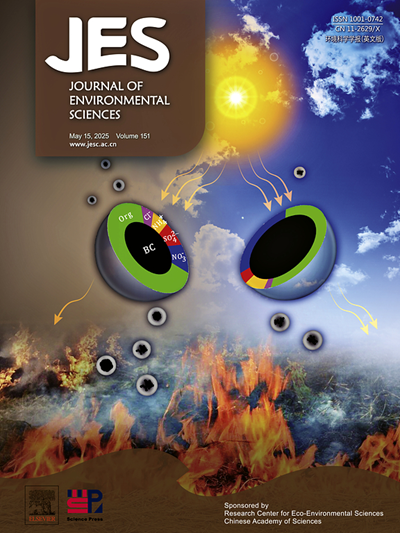The bioaccessible and labile contents of As(Ⅲ) and As(V) in four typical soils in China assessed by different methods
IF 5.9
2区 环境科学与生态学
Q1 ENVIRONMENTAL SCIENCES
引用次数: 0
Abstract
Soil bioaccessible and labile As were extracted using in vitro, diffusive gradients in thin films (DGT) and chemical extraction methods. The results showed that As(Ⅲ) was readily converted to As(V) in the soils, which was promoted by alkaline conditions and higher content of easily reducible Mn. As(V) was not readily reduced to As(Ⅲ) in these soils. The effect of soil pH on bioaccessible As content by in vitro method and labile As content by DGT method were inconsistent among different soils due to the coincidence of As(Ⅲ) and As(V), with As(Ⅲ) being more readily mobilized in acidic environment while the opposite was true for As(V). The labile As extracted by phosphate was significantly correlated with that extracted by in vitro method, while the labile As extracted by the DGT was correlated with that extracted by the CaCl2 method. The labile As extracted by the DGT was much lower than that by the in vitro and phosphate methods. The in vitro and phosphate methods extracted As in soils which is tightly bound to Fe oxides through dissolution, complexation and ion exchange. In contrast, the DGT method relied on the adsorption of soil labile As onto ZrO-based binding layer. The higher contents of soil Fe oxides and greater adsorption capacity for As led to the lower content of As measured by the DGT method. In conclusion, the in vitro and phosphate extraction are potential to be used to predict soil bioaccessible As. The DGT method is more suitable for ecological risk prediction.
采用不同方法评价了中国4种典型土壤中As(Ⅲ)和As(V)的生物可达性和不稳定性
采用体外、薄膜扩散梯度(DGT)和化学萃取法提取土壤生物可及性和不稳定性砷。结果表明,As(Ⅲ)在土壤中极易转化为As(V),主要受碱性条件和高还原性Mn含量的促进。As(V)在这些土壤中不易还原为As(Ⅲ)。由于As(Ⅲ)和As(V)重合,不同土壤pH对体外法测定的生物可达As含量和DGT法测定的不稳定As含量的影响不一致,As(Ⅲ)在酸性环境中更容易被动员,而As(V)则相反。磷酸法提取的不稳定As与体外法提取的不稳定As显著相关,DGT法提取的不稳定As与CaCl2法提取的不稳定As显著相关。DGT法提取的不稳定As远低于体外法和磷酸法提取的不稳定As。体外法和磷酸盐法通过溶解、络合和离子交换等方法提取土壤中与铁氧化物紧密结合的砷。相比之下,DGT方法依赖于土壤不稳定As在zro基结合层上的吸附。由于土壤铁氧化物含量较高,对砷的吸附能力较强,DGT法测定的砷含量较低。综上所述,体外培养法和磷酸盐提取法可用于预测土壤生物可达性砷。DGT方法更适合于生态风险预测。
本文章由计算机程序翻译,如有差异,请以英文原文为准。
求助全文
约1分钟内获得全文
求助全文
来源期刊

Journal of Environmental Sciences-china
环境科学-环境科学
CiteScore
13.70
自引率
0.00%
发文量
6354
审稿时长
2.6 months
期刊介绍:
The Journal of Environmental Sciences is an international journal started in 1989. The journal is devoted to publish original, peer-reviewed research papers on main aspects of environmental sciences, such as environmental chemistry, environmental biology, ecology, geosciences and environmental physics. Appropriate subjects include basic and applied research on atmospheric, terrestrial and aquatic environments, pollution control and abatement technology, conservation of natural resources, environmental health and toxicology. Announcements of international environmental science meetings and other recent information are also included.
 求助内容:
求助内容: 应助结果提醒方式:
应助结果提醒方式:


